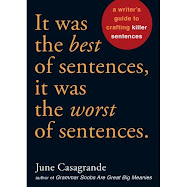"Separating out the variables quickly clarifies to job hunters concerned about earning power [and] which fields pay most."
It contains a mistake that got past a wire editor, then a section editor. It got past me. It got printed on a proof page. Then I looked at it on paper and that's when I finally saw the mistake.
Breaking down the sentence:
Subject: separating out the variables
Verb: clarifies
Prepositional phrase: to job hunters concerned about earning power
Object of verb: which fields pay most
The writer inserted "and" because she thought that "which fields pay most" was part of the prepositional phrase — something job hunters are concerned about. Seeing it on paper and without the benefit of hearing the speaker's intonations, she didn't see that the speaker meant it as the object of the verb. The speaker meant that the act of separating "clarifies which fields pay most."
The mistake is the inserted "and."
The long prepositional phrase inserted after "clarifies" threw the writer and me and at least two other editors. So it just goes to show you ...
Well, I don't know what it goes to show you. But, whatever it is, I hope it made reading this worth your time.





6 comments:
Dude, that sentence is just plain awkward! How is it possible to make it better? Of course, the real problem is that it got past a copy editor when it was originally written, and now is doomed to being quoted in horrible ways.
Maybe put the prep. phrase first?
And this goes to show you that diagramming (or being otherwise able to break up sentences into their components) is important; therefore, I shall go on teaching it (but also because it's fun to do and please forgive my semicolon).
Re sentence diagramming: exactly. I was never taught it -- taught myself a little just a few years ago. But I wish I had been for exactly this reason. I think that seeing sentences as modular things is perhaps the best way to learn how to write effectively.
Re this sentence, speaking from my reporting background instead of from a grammar perspective, this sentence should never made the cut. It's often true that interviewees speak in very unquotable ways. But it's the writer's job to know which sentences to quote, which not to quote, and when you have to ask the interviewee the same question twenty times to get a usable response.
Of course, sometimes after an interview you realize you have almost nothing that's usable. But usually, you can quote the well-worded stuff and paraphrase the poorly worded stuff.
(Hope that came out okay. I'm still on my first cup of coffee.)
Thanks for the comment!
I did my undergrad in journalism, and I remember having that distinct problem. Ah, the glory of paraphrasing!
I learned to diagram some from Grammar for Dummies and some from the grammar book at the high school where I teach. I wish I had learned it in school, too.
My favorite thing to do, once my students have started gaining some fluency in diagramming, is to put the preamble to the Constitution on the board and show how that damn sentence is actually comprehensible when you've got it laid out that way.
I'd love to see that. In fact, if you're ever motivated to take a picture of that on the board (do the kids call 'em blackboards these days), I'd love to post the photo. Assuming it's photographable, of course.
Either way, I'm impressed by the idea alone.
Photos are not necessary; I stole it from here: http://grammar.ccc.commnet.edu/grammar/diagrams2/preamble.htm
Now I totally know what I'll be doing tomorrow morning, though! Thanks!
I love that site, but I had never delved into it far enough to find that diagram. Thanks.
Post a Comment